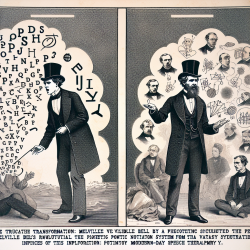For practitioners in the field of speech therapy, understanding and implementing the principles of Melville Bell's Visible Speech can offer valuable insights and tools for improving therapeutic practices. Here are some ways to integrate Bell's system into modern speech therapy:
- Enhance Articulatory Precision: Utilize Bell's detailed symbols to help clients visualize and understand the specific movements of their articulators. This can be particularly beneficial for those with articulatory disorders.
- Historical Context: Study the evolution of phonetic notation systems to appreciate the historical foundations of current practices. This understanding can foster a deeper appreciation for the techniques and tools used in therapy today.
- Comparative Phonetics: Use Bell's system to compare phonetic representations across different languages. This can aid in teaching pronunciation and understanding linguistic variations, which is especially useful for multilingual clients.
- Customized Therapy Plans: Implement Bell's approach to create customized therapy plans that address specific speech issues such as stuttering and articulation problems. The detailed phonetic symbols can help in pinpointing and correcting specific speech errors.
Despite its historical significance, some aspects of Bell's Visible Speech were lost to posterity. The intricate symbols, while precise, were challenging to learn and remember, especially for those unfamiliar with the anatomy of speech production. This highlights the importance of adaptability and innovation in therapeutic practices.
By revisiting and integrating Melville Bell's contributions, practitioners can not only enhance their current methods but also contribute to the ongoing evolution of speech therapy techniques. Embracing the lessons from Bell's work encourages a blend of historical wisdom and modern innovation, fostering a richer and more effective therapeutic practice.
To read the original research paper, please follow this link: The Phonetic Notation System of Melville Bell and its Role in the History of Phonetics.










